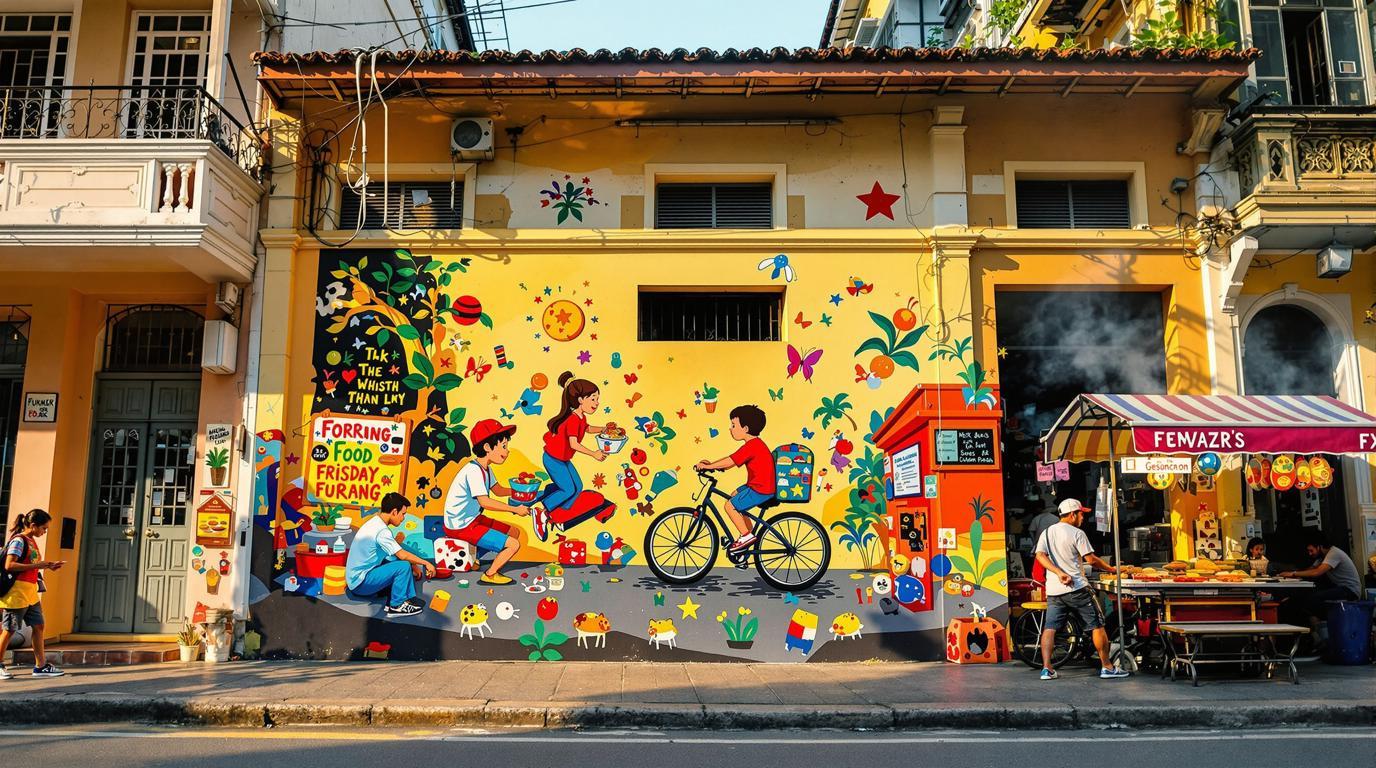Penang’s artistic streets and flavorful alleys have transformed this Malaysian island into one of Southeast Asia’s most captivating cultural hubs. Often called the “Pearl of the Orient,” George Town’s UNESCO-listed heritage district blends Chinese, Malay, Indian and colonial influences into a sensory feast where vibrant street art punctuates historic architecture and legendary hawker stalls serve some of Asia’s most celebrated cuisine.
A canvas with 52 steel-rod sculptures telling Penang’s stories
George Town’s street art revolution began after its 2008 UNESCO designation when Lithuanian artist Ernest Zacharevic created interactive murals that cleverly incorporated real-world objects. His iconic “Children on a Bicycle” mural sparked a creative movement that transformed crumbling walls into Instagram sensations.
Beyond the famous murals, Tang Mun Kian’s 52 steel-rod wire sculptures offer witty storytelling about Penang’s heritage. These intricate 3D caricatures explain local history through humor, making complex cultural narratives accessible to visitors.
“What makes Penang’s street art special is how it turns the city into a living storybook. Each piece connects to the actual place where it stands, helping people understand our multicultural history through visual stories,” explains local heritage guide Mei Lin.
The hawker food paradise with 70+ years of culinary tradition
Penang’s food scene stands as Malaysia’s culinary crown jewel, where generations of hawkers perfect recipes handed down through families. The island’s geographic position as a historic trading hub created a fusion cuisine unlike anywhere else in the world.
Char Kway Teow, wok-fried flat noodles with seafood and egg, remains the signature dish, best enjoyed from streetside stalls where chefs control intense flames under blackened woks. The iconic Penang Assam Laksa delivers a tangy, spicy fish broth that CNN once ranked among the world’s 50 best foods.
For dessert, hunt down a bowl of cendol – shaved ice with coconut milk, palm sugar, and green jelly noodles that offers sweet relief from tropical heat. Like Bali’s rising culinary status, Penang’s food scene continues drawing international attention.
The treasure hunt: finding hidden art in forgotten corners
Discovering George Town’s art requires exploration beyond typical tourist paths. Many visitors describe the experience as a rewarding treasure hunt, with new pieces regularly appearing while others slowly fade away – making each visit unique.
Early morning exploration (before 9 AM) offers the dual advantage of cooler temperatures and unobstructed photo opportunities before crowds arrive. Armenian Street contains the highest concentration of famous works, though true art enthusiasts should venture into back alleys where lesser-known local artists continue adding to the evolving outdoor gallery.
This creative energy mirrors what you’d find in Provence’s artistic villages, though with distinctly Southeast Asian flair.
Experience Penang like cultural anthropologists, not tourists
Unlike Indonesia’s more remote cultural experiences, George Town offers accessibility without sacrificing authenticity. The key is approaching your visit through a cultural lens rather than a typical tourist itinerary.
“Americans particularly appreciate our living heritage – how traditional craftspeople still practice trades like joss stick making and rattan weaving in the same shophouses their grandparents used,” notes cultural preservation advocate Tan Wei Ming.
For those seeking mountain scenery to complement urban exploration, Penang Hill provides panoramic views resembling Europe’s mountain villages but with tropical flora.
Where history’s layers reveal themselves at every turn
Much like South Africa’s historic UNESCO sites, Penang preserves multiple cultural influences within walkable districts. The Blue Mansion (Cheong Fatt Tze) exemplifies Chinese craftsmanship while colonial administrative buildings reflect British architectural influences.
Walking these streets feels like traversing multiple countries in a single afternoon – Chinese clan houses neighbor Indian temples and colonial churches, each telling part of Penang’s complex story. This multicultural tapestry creates an immersive experience where history feels immediate rather than academic.
In Penang’s George Town, street art doesn’t just decorate walls – it brings them to life, while food stalls don’t just feed visitors – they initiate them into generations of flavor traditions. Few destinations combine artistic immersion and culinary excellence so seamlessly, making this Malaysian island state worthy of any cultural explorer’s bucket list.
